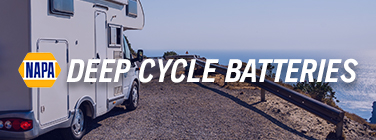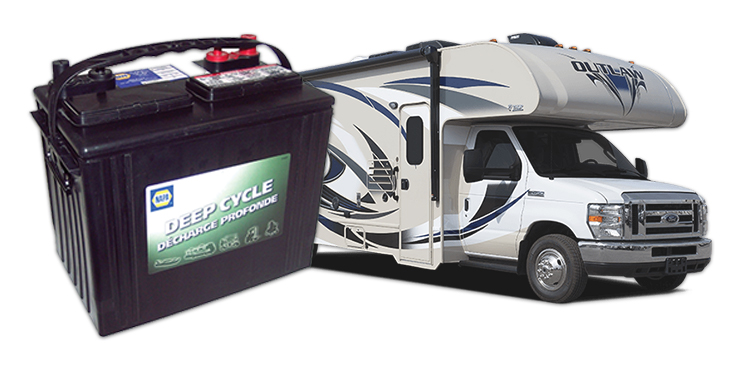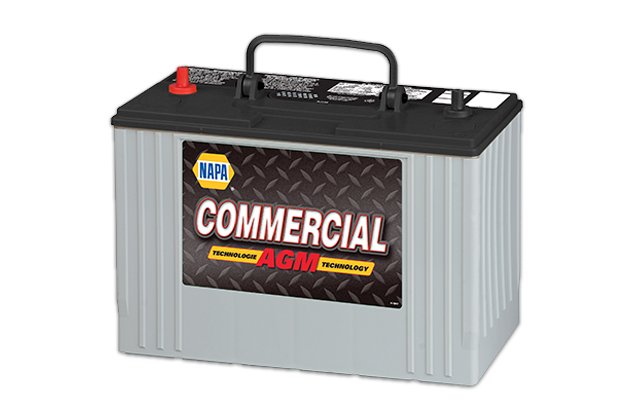


NAPA DEEP CYCLE BATTERIES
WHAT IS A DEEP CYCLE BATTERY?
Deep cycle batteries look a lot like regular car batteries, but they’re quite different. Car batteries deliver short bursts of energy – usually 2% to 5% each time you use them – before they need to be recharged by the alternator. Whereas deep cycle batteries are lead batteries designed to continuously supply power for an extended period of time and can handle deep discharges of 80% to 100% DoD (depth of discharge) before needing to be recharged. The difference between a deep cycle and a starter battery is, deep cycle batteries have thicker plates and separators, with denser active material for more corrosion resistance. The term “deep cycle” refers to the battery’s ability to discharge most of its capacity (i.e., a deep discharge) before you need to charge it. It’s important to note that although deep cycle batteries can be discharged up to 80%, most manufacturers recommend not discharging them below 45%. This will extend the life of your NAPA deep cycle battery.

FIND THE RIGHT DEEP CYCLE BATTERY!
Use our battery lookup to help you select the best deep cycle battery for your vehicle:
1. Enter the type of deep cycle battery you need (6v or 12v, wet or dry, and group size) and choose your battery.
2. Place your order online and select how you want to receive your deep cycle battery: home delivery or pickup in store.
3. Receive your order at home or pick it up at your local NAPA Auto Parts store after you receive your confirmation email.
TYPES OF DEEP CYCLE BATTERY
There are a few different types of deep cycle batteries. They each perform the same function, but the materials inside the battery are different and each one has its own pros and cons.

FLOODED LEAD-ACID BATTERY
This is the most common and affordable battery type but requires the most maintenance and has a shorter lifespan compared to other types.
The positive and negative lead plates are submerged in an electrolyte mix of sulfuric acid and water, which causes a chemical reaction during charging and discharging. This reaction produces battery vent gas, thus reducing the electrolyte level inside the battery – which then needs to be refilled. Flooded deep cycle batteries typically have a 50% usable capacity and a charging efficiency of around 70% to 85%.
ABSORBENT GLASS MAT BATTERY
The AGM battery is a type of Valve Regulated Lead Acid (VRLA) battery with a larger reserve capacity designed to deliver high-cranking amps and handle higher electrical loads.
AGM batteries have thin fiberglass mats between their lead plates. The mats function as a cushion between the lead and absorbs the electrolyte to prevent moving and spilling – making the battery shock and vibration resistant, with the ability to withstand cold temperatures. This way, manufacturers can pack more glass mats and lead into the battery to generate more power. AGM batteries are also equipped with valves to regulate the hydrogen and oxygen released during charging, and typically have a 95% charge efficiency and 80% depth of discharge.
Overall, AGM batteries tend to last longer than regular car batteries and require no maintenance, but they’re more expensive than flooded batteries.


GEL CELL
Like the AGM battery, the gel cell (or gel mat) battery is a Valve Regulated Lead Acid (VRLA) battery, although it is still considered a wet cell battery. Gel batteries cost more and are not as common as other battery types.
Like a traditional flooded battery, a gel cell battery is filled with an electrolyte and mixed with sulfuric acid and a silica additive that causes the solution to set or stiffen, creating a gel. With a stationary gel substance, the battery can be installed in various orientations without spilling. Gel batteries are valve regulated, and they typically have a charge efficiency of 85% to 90%. They also have excellent hot weather tolerance and don’t produce battery vent gas, which means they don’t require any maintenance. However, gel batteries are sensitive to overcharging and require a charger that’s compatible with a gel profile.
